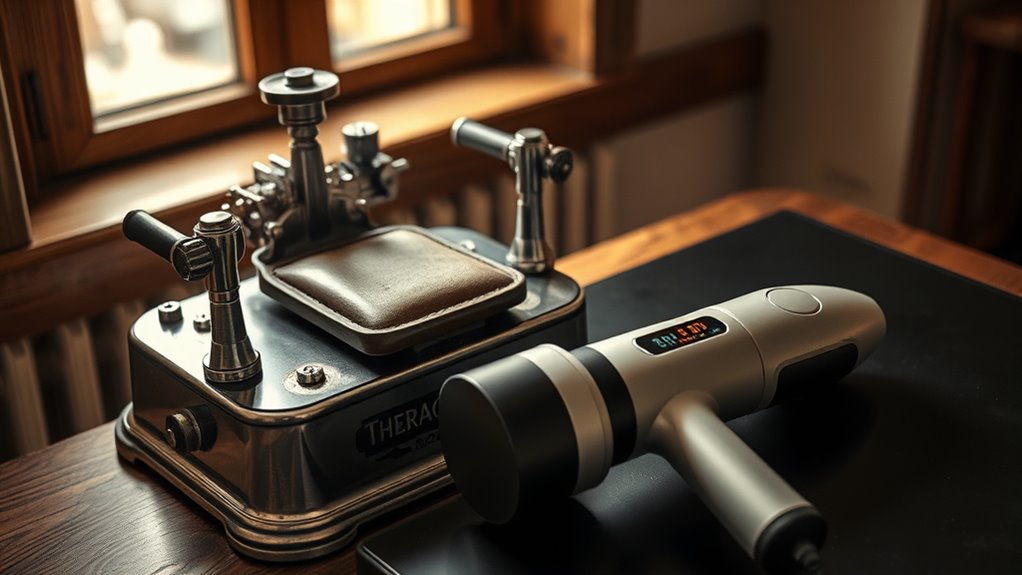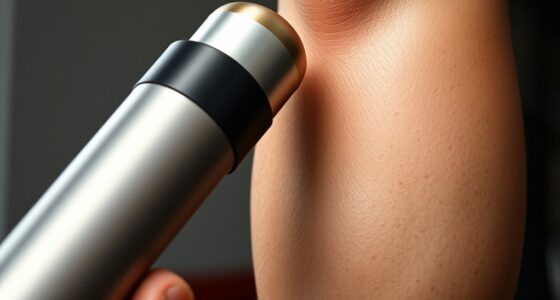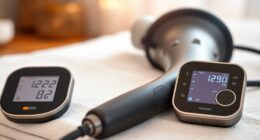Percussive therapy started with early vibration devices in the 19th century that used rhythmic taps to relax muscles and promote healing. Over time, these devices evolved into more advanced vibrational tools driven by scientific research, with innovations like Theragun making therapy portable and user-friendly. Today’s modern devices incorporate smart features, silent motors, and customizable settings. If you explore further, you’ll discover how these innovations transformed muscle recovery into a widely accessible wellness practice.
Key Takeaways
- Early 19th-century devices used rhythmic taps and vibrations to relax tissues and promote healing, laying the groundwork for modern percussive therapy.
- Vibrational machines evolved from simple muscle stimulators to mainstream tools, supported by scientific research and cultural acceptance.
- Technological advances introduced adjustable settings, sensors, and ergonomic designs, enhancing personalized muscle recovery solutions.
- The emergence of portable, battery-powered devices like Theragun revolutionized accessibility and effectiveness in muscle therapy.
- Ongoing innovations, including smart connectivity and customization, continue to shape the future of percussive therapy technology.
Early Innovations in Muscle Stimulation
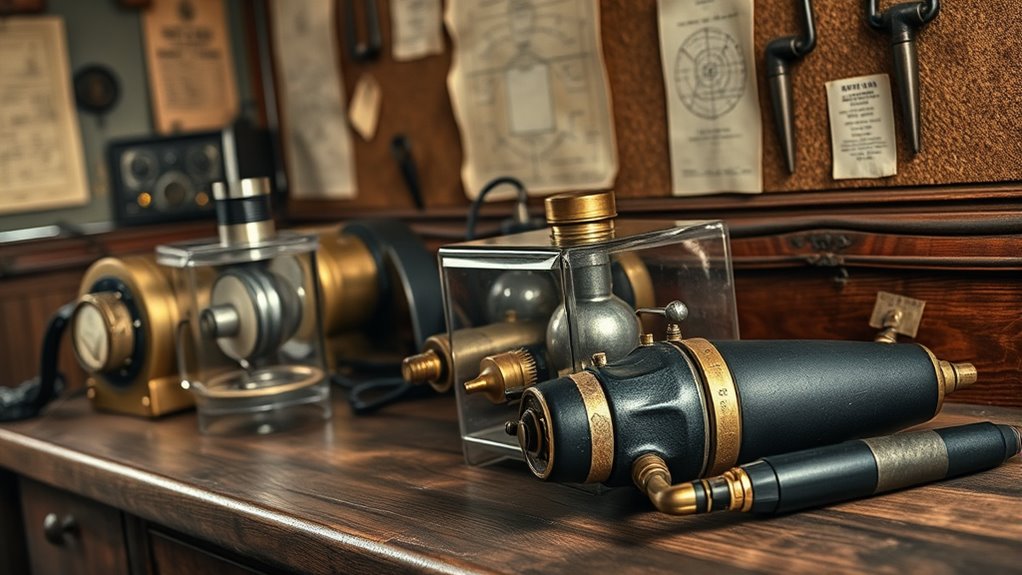
Early innovations in muscle stimulation laid the groundwork for modern percussive therapy. These early devices aimed to reduce muscle fatigue and provide pain relief through mechanical vibrations. In the 19th century, inventors experimented with simple machines that delivered rhythmic taps or vibrations to muscles, helping to relax tight tissues and boost circulation. You would feel the vibrations penetrate deep into muscles, alleviating soreness and easing discomfort. This approach was especially useful for athletes and patients recovering from injury. While primitive, these devices demonstrated that targeted mechanical stimulation could promote healing and reduce pain. Over time, the technology evolved, becoming more effective and user-friendly, setting the stage for the sophisticated percussion devices we use today.
The Rise of Vibrational Devices for Therapy

How did vibrational devices shift from simple muscle stimulators to essential tools in modern therapy? The historical context reveals a gradual evolution driven by scientific research and increasing awareness of their benefits. Initially, these devices were basic and used mainly for muscle stimulation, but cultural influence played a role in expanding their applications. As people recognized their potential for pain relief and relaxation, demand grew, leading to innovations. This widespread acceptance helped integrate vibrational therapy into mainstream healthcare, sports recovery, and wellness practices. Today, vibrational devices are valued for their versatility and effectiveness, transforming from niche equipment into crucial tools for improving physical health. Their rise reflects a blend of scientific validation and cultural shifts toward holistic, non-invasive treatments, and understanding the sound healing science behind vibrational therapy continues to support its credibility.
Technological Advancements and Scientific Insights
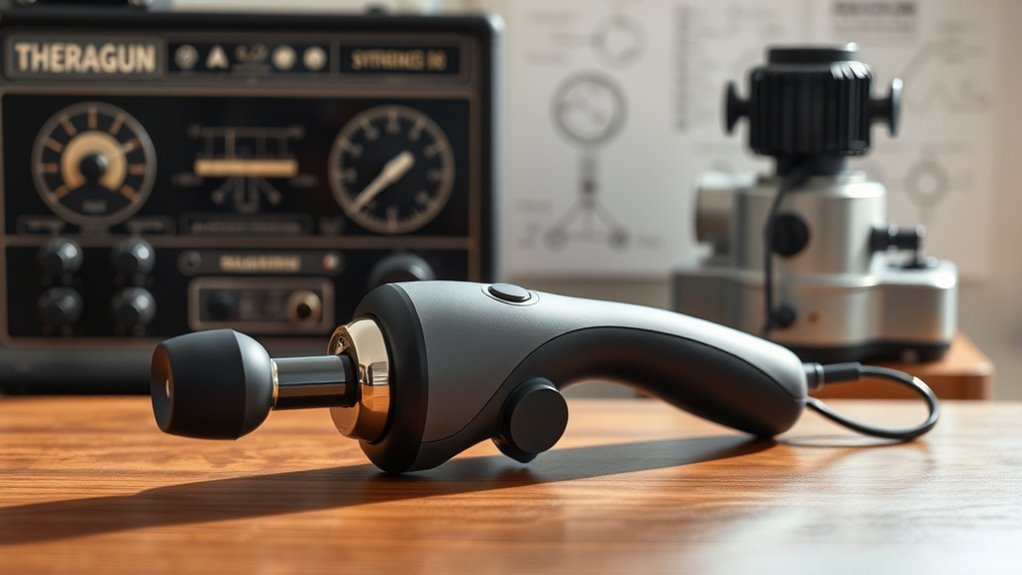
Advancements in technology and scientific research have propelled vibrational devices from simple tools to sophisticated therapeutic instruments. This evolution reflects a rich historical context and the influence of diverse cultures shaping modern percussive therapy. Today’s devices incorporate precise control over speed, pressure, and frequency, driven by breakthroughs in biomechanics and neuroscience. Cultural influences, like traditional Chinese medicine and massage practices, inform modern designs and techniques. Imagine:
- Compact devices with adjustable intensity levels
- Sensors that monitor muscle response in real-time
- Ergonomic grips blending form and function
- Data analytics guiding personalized treatment
- Quiet motors enabling discreet use anywhere
These innovations deepen your understanding of muscle recovery, pain relief, and overall wellness, demonstrating how scientific insights and cultural history continue to push percussive therapy forward. Incorporating tokenization and smart contract technologies, the industry is experiencing unprecedented growth and transparency, further advancing the development of innovative therapeutic devices.
Emergence of Portable Percussive Tools

You’ll notice how portable percussive tools have become more compact and ergonomic, making them easier to use on the go. Battery-powered models offer convenience without cords, so you can treat yourself anywhere. This evolution has markedly increased access to percussive therapy for both professionals and enthusiasts. Additionally, Kia Tuning options now include performance modifications that enhance vehicle handling and power, paralleling the advancements in portable therapy devices.
Compact Design Evolution
The evolution of percussive therapy devices has led to the development of compact, portable tools that offer users greater convenience and flexibility. These devices prioritize ergonomic design, fitting comfortably in your hand for extended use. The user interface has become more intuitive, with simple controls and clear displays, making it easy to customize your treatment. Imagine holding a lightweight device with a sleek, rounded shape that contours naturally to your body. You can effortlessly switch between different intensity levels or massage modes with a quick tap. Picture a device small enough to slip into your pocket or gym bag, ready whenever you need it. This evolution empowers you to enjoy targeted relief anytime, anywhere, without sacrificing functionality or comfort. Advancements in technology continue to enhance device performance and user experience, making percussive therapy more accessible and effective for everyone.
Battery-Powered Convenience
Battery-powered percussive devices have revolutionized how you incorporate massage therapy into your routine by offering unmatched portability and ease of use. With wireless charging, you no longer need to fuss with cords or outlets, making it simple to keep your device ready at a moment’s notice. The ergonomic design ensures a comfortable grip, allowing you to target sore muscles precisely and effortlessly. These features make portable tools ideal for on-the-go recovery, whether at home, the gym, or traveling. The convenience of cordless operation means you can focus on your therapy without interruption. As technology advances, these devices become even more user-friendly, combining power, portability, and smart charging options to meet your needs seamlessly. Additionally, incorporating tuning principles from automotive modifications can inspire innovative approaches to optimizing device performance and durability.
Increased Accessibility
Have portable percussive tools truly expanded access to massage therapy for everyone? Absolutely. These compact devices make it easier to target muscle fatigue and pain relief anytime, anywhere. No longer do you need a visit to the therapist’s office; you can now incorporate percussive therapy into your daily routine. Imagine:
- Slipping a lightweight device into your gym bag after workouts
- Using it discreetly at your desk during breaks
- Applying it in the comfort of your home after a long day
- Carrying it on trips for instant muscle recovery
- Quickly easing tension before bedtime
These portable tools bridge the gap, allowing more people to experience the benefits of percussive therapy. They provide convenient, on-demand relief, making muscle recovery accessible even during busy schedules.
The Development and Popularization of Theragun
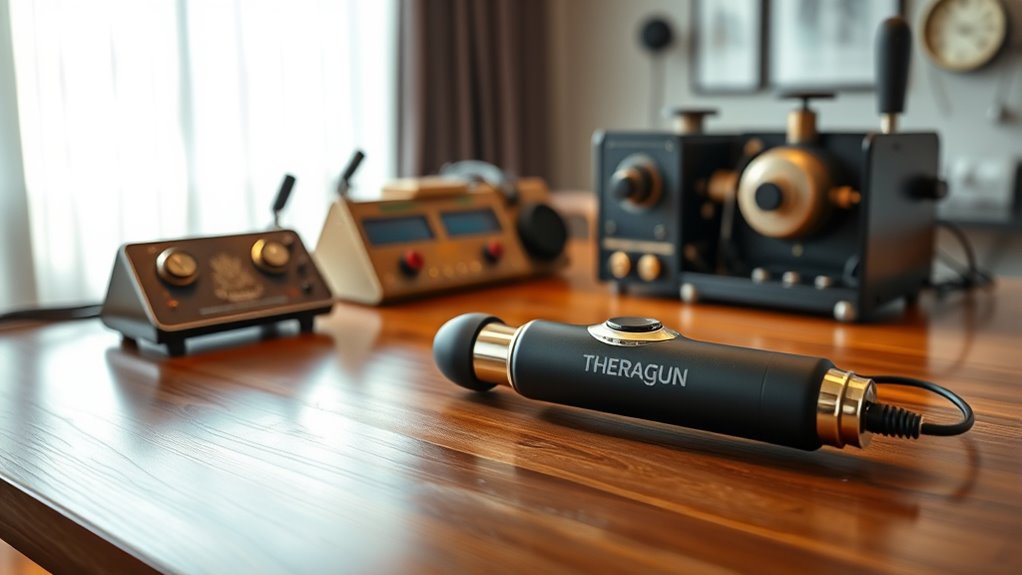
You’ve likely heard of Theragun, but its development revolutionized percussive therapy. By inventing effective, user-friendly devices, Theragun changed how people approach muscle recovery. Its market impact has made percussive therapy a mainstream wellness tool. Incorporating natural materials and creating a cozy, rustic feel contributed to the device’s appeal in the wellness community.
Inventing Percussive Devices
The development and popularization of Theragun marked a significant milestone in the evolution of percussive therapy devices. You can now experience targeted muscle rejuvenation and pain relief with ease. These devices transformed the way athletes and everyday users approach recovery and relaxation. Imagine:
- A sleek, ergonomic design fitting comfortably in your hand
- Quiet motors delivering powerful yet soothing percussive strokes
- Adjustable speed settings tailored to your needs
- Compact size for portability during travel or at the gym
- Interchangeable attachments targeting specific muscle groups
This innovation made percussive therapy accessible and effective, changing the landscape of muscle recovery. It’s no longer just about vibration machines but about precision devices that promote healing, reduce soreness, and enhance performance. Vibration machines initially laid the groundwork for these advancements by introducing the concept of mechanical oscillation for therapeutic purposes.
Theragun’s Market Impact
Theragun’s introduction revolutionized the percussive therapy market by making advanced muscle recovery technology widely accessible. Its innovative design and effective results spurred rapid consumer adoption, transforming how people approach muscle relief. As Theragun gained popularity, it intensified market competition, prompting other brands to innovate and improve their offerings. The company’s strategic marketing and focus on professional endorsements helped build credibility, making percussive therapy mainstream. This surge in consumer interest not only expanded the market but also pushed industry standards higher. Additionally, the rise of Gold IRA Rollovers and other diversified retirement investment options has underscored the importance of incorporating health and wellness tools into a comprehensive approach to long-term well-being. Today, Theragun’s influence continues to shape the industry, pushing competitors to develop comparable devices and further popularize percussive therapy as a crucial tool for recovery and wellness.
Modern Percussive Therapy and Future Directions
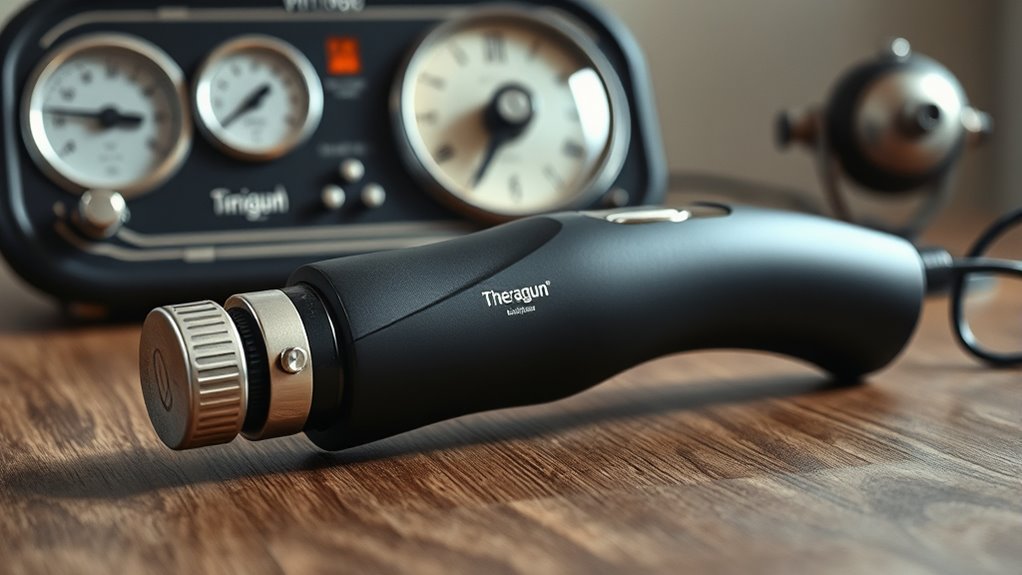
Have advancements in technology transformed percussive therapy into a more precise and accessible tool? Absolutely. Today’s devices feature customizable settings, smart sensors, and ergonomic designs, making muscle recovery and pain relief more effective. Imagine:
- Compact, handheld devices fitting easily in your hand
- Adjustable speed and intensity for targeted relief
- Bluetooth connectivity for personalized programs
- Quiet motors for discreet use anywhere
- Real-time feedback on muscle tension
- Incorporating personality insights can help users better understand how they respond to different therapy intensities, optimizing their recovery experience.
Frequently Asked Questions
How Did Early Inventors Discover the Benefits of Vibration for Muscle Relief?
You might wonder how early inventors discovered vibration’s benefits for muscle relaxation and pain relief. They likely observed that gentle shaking or tapping eased tight muscles and reduced discomfort, perhaps through trial and error or by noticing effects during massage or manual therapy. Over time, they refined these techniques, realizing that consistent vibration helped promote blood flow, loosen muscles, and provide effective relief, laying the foundation for modern percussive therapy devices.
What Materials Were Initially Used in Early Vibrational Therapy Devices?
Imagine the rough, metallic feel of early vibrational therapy devices as you hold them in your hand. You’d notice that historical materials like wood, metal, and rubber made up the core of early device construction. These sturdy, accessible materials allowed inventors to create simple, effective tools for muscle relief, relying on the durability and resonance of metals and the flexibility of rubber to deliver vibrations directly to sore muscles.
How Do Scientific Studies Support the Effectiveness of Percussive Therapy?
Scientific studies show that percussive therapy effectively boosts muscle recovery and reduces pain. You can see improvements as the therapy increases blood flow and relaxes tight muscles, helping your body heal faster and easing discomfort. Research supports its use for athletic recovery and chronic pain management, making it a valuable tool for enhancing performance and well-being. Overall, evidence backs percussive therapy’s role in supporting your muscle health and pain relief.
What Challenges Were Faced in Miniaturizing Vibrational Devices for Portability?
Did you know that over 60% of users want portable vibrational devices? When miniaturizing these devices, you face challenges like maintaining battery power and ensuring ergonomic design. You need to balance compact size with enough battery life for effective therapy sessions, all while keeping the device comfortable and easy to use. Overcoming these hurdles helps you enjoy powerful, portable percussive therapy without sacrificing performance or comfort.
How Has Consumer Feedback Influenced the Design of Modern Percussive Tools?
You’ve influenced modern percussive tools considerably through your feedback. Manufacturers prioritize your user experience by refining ergonomic design, making devices easier and more comfortable to handle. Your input drives innovations like quieter motors, adjustable intensity, and portable sizes. As a result, these improvements guarantee the tools meet your needs more effectively, enhancing your overall therapy experience and encouraging consistent use. Your feedback truly shapes the evolution of percussive therapy devices.
Conclusion
So, after all this history, it’s clear that percussive therapy has come a long way— from clunky vibration machines to sleek Theraguns. Now, you can effortlessly bounce back from soreness with a device that’s basically a high-tech massage robot. Who knew that your quest for muscle relief would turn into a high-stakes gadget obsession? Honestly, next time you use one, just remember: science and a bit of modern wizardry made this miracle possible.
